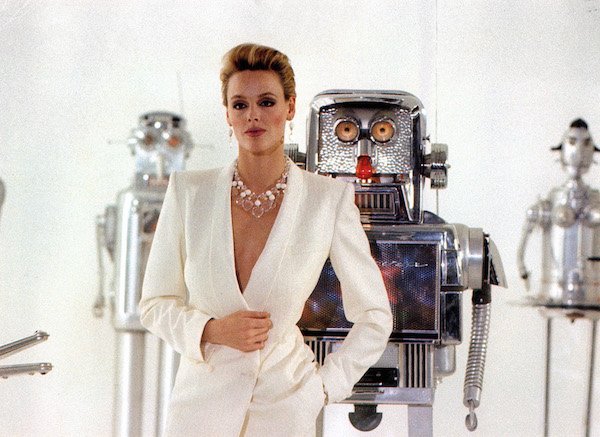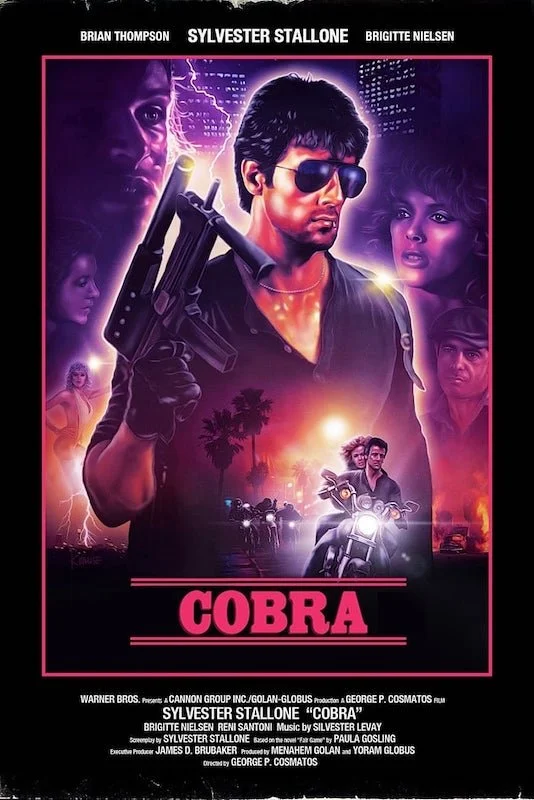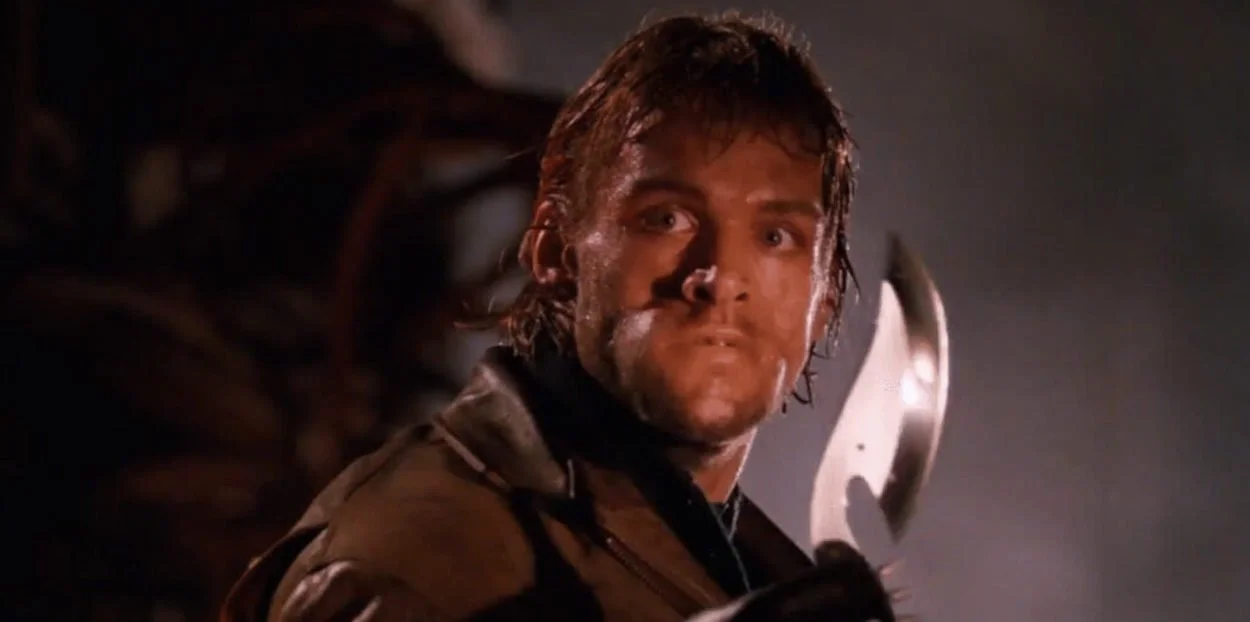COBRA (1986)
Cheap Christmas decorations adorn the windows of a dingy grocery store in an attempt to give the dismal setting some holiday cheer. Huddled inside the dim building are terrified customers being held against their will by a shotgun-wielding zealot who nonsensically raves about being a “hero and hunter of the new world.” The police surrounding the area are impotent with indecision and in-fighting. Finally, the call is made—send in “The Cobra”, Lieutenant Marion Cobretti, a man who personifies all the violent, powerful things that the hostage-taker claims to be. Once on the scene, Cobretti single-handily takes down the lunatic but not before emasculating him with the dismissive label of being a “lousy shot.” An insult of the highest order for a modern-day gunslinger directed at an obvious pretender meant to cut as deep as the knife that, moments later, Cobretti plunges into the criminal’s trembling chest.
So opens the 1986 action film COBRA starring Sylvester Stallone as the titular super cop. This live-action, Reagan-era hellscape cartoon of fascist law enforcement and crazed cultists finds Stallone reuniting with director George P. Cosmatos (with whom Stallone previously worked on RAMBO: FIRST BLOOD PART 2 the year before) for a film that was intended to be a standard “cop movie” about the title character working to stop a serial killer dubbed “The Night Slasher” (a perpetually sweaty Brian Thompson) and his crazed followers, while at the same time protecting the only witness (Brigitte Nielsen) who has seen the madman’s face and lived to talk about it. However, actually experiencing the film reveals it as one of the strangest—and bleakest—entries in Stallone’s lengthy career.
The reality of watching COBRA feels akin to witnessing a pair of vaguely-defined constructs clashing over whose “might makes right” worldview will be upheld: the one where the weak are protected yet controlled or the one where those same people are actively culled from the population.
There is no insight or backstory adding thoughtful nuance to this conflict of violent caricatures struggling for implied ideological dominance; just mayhem, held together by the barest of narrative threads, barreling towards an inevitable deadly showdown that takes the nihilistic and hellish subtext of the film and brings it forward with all the subtlety of a fiery car crash.
This fascinating vibe that COBRA has is the (likely accidental) result of a heavy handed post-production process that saw large chunks of the initial cut of the film being removed to not only tone down the graphic bloodshed, so it could obtain an “R” rating required for theatrical exhibition, but to also dramatically shorten the film’s runtime in an effort to maximize profit potential at the box office.
To put it bluntly, the film was hacked to the bone like it was an unsuspecting victim of The Night Slasher himself...and, surprisingly, is more interesting for it.
The aggressive editing of the film renders nearly every moment of action into a strangely compelling kaleidoscope of violent imagery. Continuity and coherency are thrown out the window of a speeding 1951 Mercury in favor of rapid images of bodies flying, knives slashing, and machine guns rattling off endless rounds of ammunition as Cobretti and The Night Slasher work their way towards their apocalyptic battle with each other.
Even when COBRA briefly gives the screen over to something other than action, the effect of the heavy trims is no less surreal and fascinating. Major supporting characters like Nielsen’s Ingrid and Cobretti’s partner, Gonzales (Reni Santoni), are given no personality traits other than a love of trashy food (yes, both of them).
Cobretti gently mocks them for this shared shortcoming in fleeting character moments that are clearly intended to humanize Stallone’s character. In reality though, these strange asides just illustrate that Cobretti, like The Night Slasher, looks down on people that don’t share his disciplined, warrior outlook.
It may not be as exaggerated and monstrous as the villain’s outlook but the contempt is still there. One man sees normal people as a flock in need of protection from the evils of the world, both big and small. The other sees them as lambs to be slaughtered...but still, both men see only lost sheep.
These unintentional parallels between cop and killer don’t end there. More become apparent when looking at the film’s strong horror elements. Thompson’s portrayal of The Night Slasher is all blind determination, nothing matters but the end goal of destruction. His twisted spartan ideals are mirrored by Cobretti’s own steadfast commitment to justice. At different times in COBRA, both men are shown in moments that should be quiet bits of rest but instead are used only to prep for more conflict. It’s as if neither character can fully exist without the looming idea of potential violence.
Brian Thompson’s Night Slasher feels as if he could have stepped out of any number of “slasher” films, from the time period of COBRA’s release, with his craggy face, imposing stature, intense stare, and unique weapon of choice (a wickedly exaggerated trench knife that spawned countless flea market knock-offs). It is all right there is his name, after all—he’s a horror archetype dropped into an action film setting and let loose. The horror aesthetic isn’t limited to just his look though.
Stallone’s Cobretti with his mirrored sunglasses that obscure most of his face and mostly black outfit including patent leather gloves would fit right in as the killer in a moody Giallo (“IL COBRA COLPISCE,” maybe?). As both men prowl the urban landscape that’s been adorned with the occasional flash of ironic Christmas decor, hunting their chosen prey, it’s easy to picture a full-fledged horror film stealthfully emerging from this action film scenario. And in a way, that’s exactly where the finale ends up.
Near the end of the film, after Cobretti and Ingrid have survived a zombie-like assault from The Night Slasher’s motorcycle-riding followers, they find themselves cornered in an isolated foundry, literally surrounded by flames and monsters who wish to do them harm. Here, with no other choice, Cobretti fully embraces the apex predator aspect of his nature and namesake. He stalks the cultists and dispatches them with a ruthless efficiency that cements him as just as much of a “boogeyman” as The Night Slasher.
When the two finally square off, both now fully drenched in the sweat of death and destruction as fires burn all around them, it’s not a simple showdown of cop and killer anymore. It’s a clash between violent demons for supremacy over a man-made Hell.
Cobretti makes that clear as The Night Slasher tries to taunt him with the futility of society’s law.
“The court is civilized isn’t it, pig?”
“But I’m not. This is where the law stops and I start ... !"
Of course, Cobretti quickly and viciously destroys his challenger, literally skewering The Night Slasher and banishing him into the hungry flames that surround their makeshift arena. After it’s all over, Cobretti claims a cultist’s motorbike and Ingrid, as his spoils of war and the pair ride off together as the jarringly incongruent sounds of “Voice of America’s Sons” by John Cafferty & The Beaver Brown Band play over the scene leading into the end credits.
The jazzy, upbeat tune and the picturesque scenery of the final moments are clearly intended to send the viewer away thinking they just saw a typical, fun, action romp but those two overly sunny gestures don't do much to blunt the darkness of COBRA. They are as affecting as cheap Christmas decorations hastily affixed to a grimy window.








